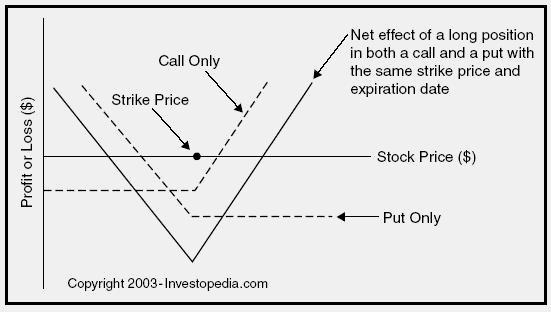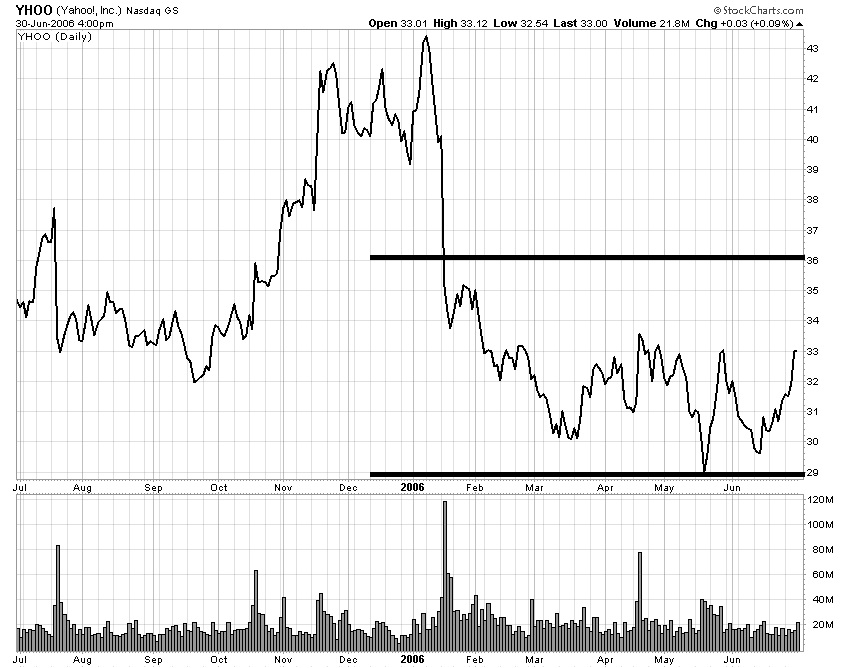Binary Options Straddle Strategy
The Straddle Strategy Review
The straddle strategy is a popular trading strategy in the options market. In order to understand the straddle trade, one must understand what the term “straddle” means. When referencing human activity, to “straddle” means to stand on two legs, with each leg on opposite sides of a reference point. So in setting up a straddle trade, the trader must two positions (the put and the call), setup strike prices for each position and also set the expiry date/time. In essence, this strategy involves buying a put option at the top and a call option at the bottom. This is illustrated this way:

Buy 1 ABC AUG 50 Put @ $2.00/share or $200/contract
Buy 1 ABC AUG 50 Call @ $2.00/share or $200/contract
• where 1 represents the number of option contracts. 1 option contract = 100 shares
• XY is the underlying asset purchased (which could be a stock, ETF or commodity)
• 50 and 55 are the strike prices of the of the put and call option respectively
The Straddle Does Not Suck…IT ROCKS!
I love the straddle. This is because the profit potential is unlimited. Indeed, the farther away the price of the asset on expiry is from the market price at the time of purchasing the option, the greater the profit that the trader will make. It does not matter if the asset price goes up or down; the trader will make money. I cannot think of a better kind of trade to make in the options market.
Trading Scenarios
Profit: The profit potential in a straddle trade is unlimited. This is because no matter where the price is headed, the long positions for both call and put options will provide the necessary cover for profitable trades. All that is needed is for the price of the asset to move away from the market price at the time the straddle trade was setup.
a) If ABC is at $60 on expiration, the call option will be in the money while the put will expire out-of-the-money. The value of the straddle is calculated as follows:
Profit from call option= New asset price on expiry – Strike price of call option = (60 – 50) X 100 = $1000
Value of put option = $0
Cost of trade = cost of call + cost of put = 200 + 200 = $400
Earnings = $1000 – $400 = $600
b) If ABC is at $35 on expiration, the put option will be in the money and the call option will be out-of-the-money. The value of the straddle is calculated as follows:
Profit from put option = New asset price on expiry – Strike price of put option = (50 – 35) X 100 = $1500
Value of put = $0
Cost of trade = cost of call + cost of put = 200 + 200 = $400
Earnings = $1500 – $400 = $1100
Loss:
This is restricted to the cost of the trade, which in our example is $400. Losses occur when the price of the asset is unchanged at expiry, or has not changed sufficiently to surpass the trade costs.
My Conclusion
It is necessary to determine a correct timing for entering into a transaction. You should not only make a timely entrance into the put and call options: an essential decision on whether to start such a transaction under prevailing market conditions has to be made. Only when you are aware of the market bias for the traded asset and the calendar of news releases, can you afford to play the straddle strategy.
You need the asset price to change in order to profit from the straddle strategy. Under quiet market conditions, the price of the asset will not move enough for your earnings to exceed your trade costs. On the other hand, high volatility and an uncertainty in the market encourage the straddle strategy. Accordingly, important news releases and fundamental data announcements favour the strategy as unexpected positive or negative surprises could significantly affect prices over a short period of time.
